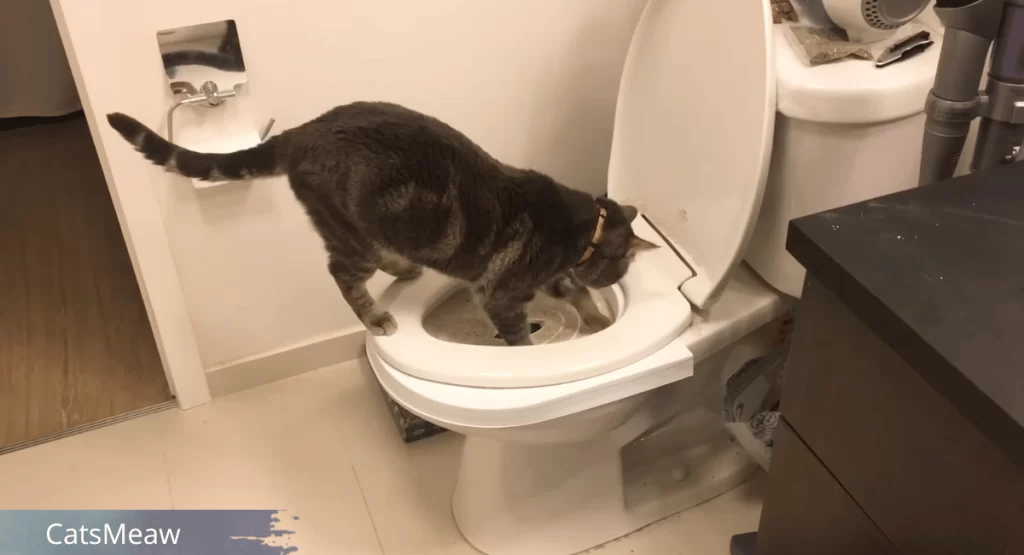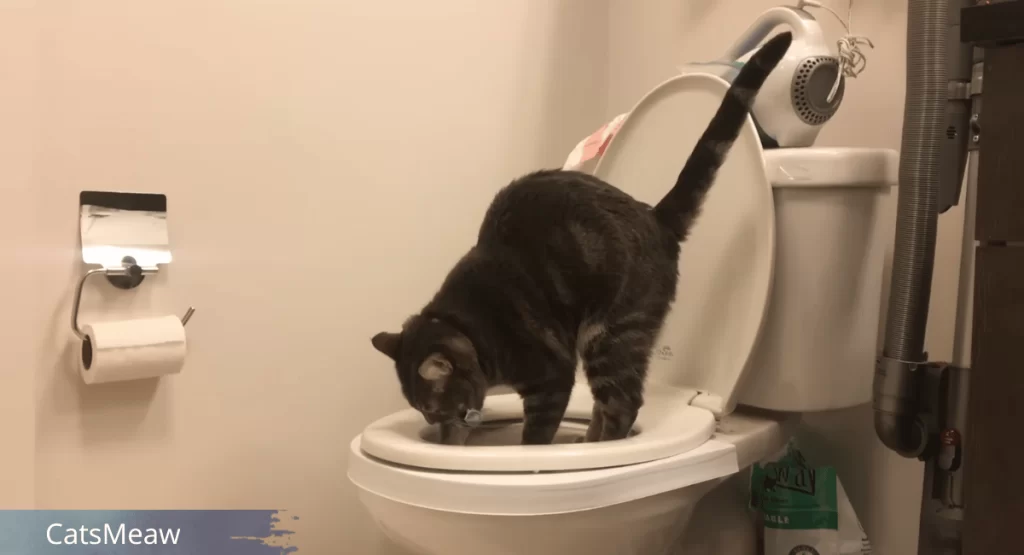Training your cat to use the toilet can be a game-changer for both you and your feline friend. By eliminating the need for a litter box, you can enjoy a cleaner and more hygienic home. But beyond the convenience, there are several other reasons why to train your cat to use the toilet is beneficial.

Firstly, it eliminates the unpleasant odor associated with traditional litter boxes. No more scooping and constantly changing litter. Secondly, it saves you money in the long run. Litter can be expensive, and with a toilet-trained cat, you won’t have to worry about buying it anymore. Lastly, it reduces the environmental impact of using litter. By going litter-free, you’re contributing to a greener planet.
Table of Contents
The benefits of toilet training your cat
Toilet training your cat comes with a plethora of benefits that go beyond the elimination of litter. Cats are naturally clean animals, and by training them to use the toilet, you’re tapping into their innate instincts. This can lead to improved overall hygiene and a happier cat.
Another advantage of toilet training is that it reduces the risk of litter box-related health issues. Some cats develop allergies or respiratory problems due to the dust and chemicals present in litter. By eliminating the need for litter, you’re minimizing the chances of your cat developing such issues.
Furthermore, a toilet-trained cat is a more independent cat. Unlike dogs, cats are self-sufficient animals, and by teaching them to use the toilet, you’re empowering them to take care of their own business. This can result in a stronger bond between you and your cat, as they feel more confident and self-reliant.
Understanding your cat’s natural instincts
Before embarking on the journey of toilet training your cat, it’s crucial to understand their natural instincts. Cats are incredibly clean animals, and they have an innate desire to bury their waste. This behavior stems from their wild ancestors, who needed to conceal their scent from potential predators.
By recognizing and respecting these instincts, you can make the toilet training process smoother for your cat. It’s important to provide them with a suitable alternative that mimics the act of burying their waste. This is where a c comes into play. Introduce the litter box early on, and allow your cat to become familiar with the concept of using it.
Preparing your cat for toilet training
Before you start toilet training your cat, it’s essential to ensure they are physically and mentally ready for the transition. Cats are creatures of habit, so sudden changes can be stressful for them. Take the time to prepare your cat for the upcoming training sessions.
Firstly, make sure your cat is in good health. If they are experiencing any medical issues, it’s best to address those before attempting toilet training. Additionally, ensure that your cat is comfortable using a litter box. If they are reluctant or have any negative associations with the litter box, it may be necessary to address these issues before moving forward.
Related: Best Interactive Toys for Indoor Cats
Next, gradually introduce your cat to the bathroom. Start by bringing their litter box into the bathroom and allowing them to explore the space. This helps them associate the bathroom with their familiar scent and encourages a positive connection. Once your cat is comfortable in the bathroom, you can move on to the next step: introducing the training seat.
Choosing the right litter box and accessories
When it comes to toilet training your cat, choosing the right litter box and accessories is crucial for success. There are various options available, so it’s important to consider your cat’s needs and preferences.
Firstly, select a litter box that is suitable for your cat’s size. It should be spacious enough for them to comfortably turn around and dig. Additionally, choose a litter box with low sides or one that comes with a removable front panel. This makes it easier for your cat to access the training seat once you progress to that stage.

In terms of litter, opt for a flushable and biodegradable variety. This ensures that it won’t harm the plumbing system when your cat starts using the toilet. Avoid scented litters, as cats can be sensitive to strong odors. Remember to gradually transition from your cat’s regular litter to the flushable litter, as sudden changes can be off-putting for them.
Lastly, consider investing in a training seat that fits securely onto the toilet. This seat provides a stable surface for your cat to stand on while doing their business. Some training seats even come with a built-in litter tray, which can be useful during the early stages of training.
Step-by-step guide to toilet training your cat
Now that you’ve laid the groundwork and set up the necessary accessories, it’s time to dive into the step-by-step guide to toilet training your cat.
Step 1: Familiarization – Place the training seat on the toilet with the litter box underneath. Allow your cat to get used to the new setup and use the litter box as usual.
Step 2: Gradual elevation – Gradually reduce the amount of litter in the box while elevating the training seat. This encourages your cat to start using the seat instead of the litter box.
Step 3: Transition to the toilet – Once your cat is comfortable using the training seat, remove the litter box and encourage them to use the toilet fully. You can do this by placing a small amount of flushable litter directly on the toilet seat.
Step 4: Remove the training seat – Once your cat is consistently using the toilet without any accidents, it’s time to remove the training seat altogether. Your cat should now be fully toilet trained.
Common challenges and how to overcome them
While toilet training your cat can be a rewarding experience, it’s not without its challenges. Here are some common issues you may encounter and strategies to overcome them.
Accidents – Accidents can happen during the training process. If your cat has an accident, remain calm and clean up the mess without scolding or punishing them. Revisit the previous step and reinforce the training by temporarily placing the litter box back in the bathroom.
Resistance – Some cats may be resistant to change and may take longer to adapt to toilet training. Be patient and allow your cat to progress at their own pace. Offer positive reinforcement, such as treats or praise, whenever they show progress or successfully use the toilet.
Fear of falling in – Cats have a natural fear of falling into the toilet. To alleviate this fear, consider placing a training seat with a small hole or using a toilet seat reducer. This provides a smaller, more secure surface for your cat to stand on.
Tips for successful toilet training
Toilet training your cat requires patience, consistency, and a positive approach. Here are some additional tips to ensure a successful outcome:
- Establish a routine: Cats thrive on routine, so establish a consistent schedule for training sessions. This helps your cat understand what is expected of them and reduces confusion.
- Reward good behavior: Positive reinforcement goes a long way in training your cat. Whenever your cat uses the toilet successfully, reward them with treats, praise, or playtime. This reinforces the desired behavior and motivates your cat to continue using the toilet.
- Monitor your cat’s progress: Keep a close eye on your cat’s progress throughout the training process. Note any challenges or setbacks and adjust your approach accordingly. Celebrate small victories and be patient during setbacks.
- Maintain cleanliness: Clean the toilet regularly to ensure a hygienic environment for your cat. Remove any litter residue, flushable litter, or waste promptly. This helps maintain your cat’s comfort and encourages them to continue using the toilet.
Maintaining your cat’s toilet training
Once your cat is successfully toilet trained, it’s important to maintain their good habits. Here are some key practices to ensure your cat continues using the toilet:
- Regular cleaning: Clean the toilet regularly to prevent any buildup of waste or residue. This helps maintain a hygienic environment for your cat and prevents any odors that may discourage them from using the toilet.
- Monitor for changes: Keep an eye out for any changes in your cat’s behavior or health. Sudden changes in litter box habits may indicate an underlying issue that needs to be addressed.
- Backup options: Consider having a backup litter box available in case of emergencies or if your cat is unwell. This provides a safety net for your cat and prevents accidents in case they are unable to use the toilet temporarily.
Conclusion: Enjoy a litter-free home with a toilet-trained cat
Toilet training your cat may take time and effort, but the benefits are well worth it. By eliminating the need for a litter box, you can enjoy a cleaner and more hygienic home. Additionally, toilet training taps into your cat’s natural instincts and promotes their overall well-being.
Related: Cat’s Litter Box: Best Place Put It in the House?
Remember to be patient, consistent, and positive throughout the training process. Celebrate small victories and adjust your approach as needed. With time and dedication, you can successfully train your cat to use the toilet and enjoy a litter-free home.
So, why wait? Start toilet training your cat today and experience the convenience and joy of a toilet-trained feline companion.
